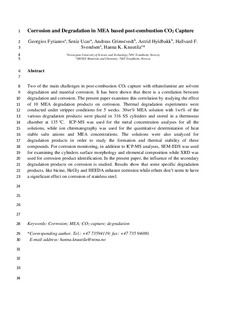Corrosion and degradation in MEA based post-combustion CO2 capture
Fytianos, Georgios; Ucar, Seniz; Grimstvedt, Andreas Magnar; Hyldbakk, Astrid; Svendsen, Hallvard Fjøsne; Knuutila, Hanna K.
Journal article, Peer reviewed
Submitted version
Permanent lenke
http://hdl.handle.net/11250/2456714Utgivelsesdato
2016Metadata
Vis full innførselSamlinger
Originalversjon
International Journal of Greenhouse Gas Control. 2016, 46 48-56. 10.1016/j.ijggc.2015.12.028Sammendrag
Two of the main challenges in post-combustion CO2 capture with ethanolamine are solvent degradation and material corrosion. It has been shown that there is a correlation between degradation and corrosion. The present paper examines this correlation by studying the effect of 10 MEA degradation products on corrosion. Thermal degradation experiments were conducted under stripper conditions for 5 weeks. 30 wt% MEA solution with 1 wt% of the various degradation products was placed in 316 SS cylinders and stored in a thermostat chamber at 135 °C. ICP-MS was used for the metal concentration analyses for all the solutions, while ion chromatography was used for the quantitative determination of heat stable salts anions and MEA concentrations. The solutions were also analysed for degradation products in order to study the formation and thermal stability of these compounds. For corrosion monitoring, in addition to ICP-MS analyses, SEM–EDS was used for examining the cylinders’ surface morphology and elemental composition while XRD was used for corrosion product identification. In the present paper, the influence of the secondary degradation products on corrosion is studied. Results show that some specific degradation products, such as Bicine, HeGly and HEEDA, enhance corrosion while others do not seem to have a significant effect on corrosion of stainless steel.
